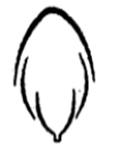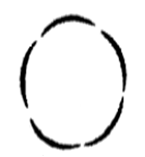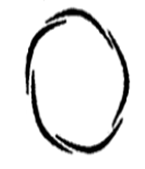Biology Chapter 6 Anatomy Of Flowering Plants
Sponsor Area
NCERT Solution For Class 11 Political+science Biology
State the location and function of different types of meristems.
Meristems are specialised regions of active cell division in plants. The meristems represent the regions of growth. Growth is largely restricted to the meristem regions of the plant. Depending on their location the meristems are of three types.
(i) Apical meristem:
These meristems are present at the tips of the roots and shoots. The shoot apical meristem is present at the tip of the shoots and its active division results in the elongation of the stem and formation of new leaves. The root apical meristem helps in the elongation or growth of roots. They are primary meristems as they appear early in the plant life.
(ii) Intercalary meristem:
These are present between the masses of mature tissues present at the bases of the leaves of grasses. It helps in the regeneration of grasses after they have been grazed by herbivores. They are primary meristem.
(iii) Lateral meristem:
It appears in the mature tissues of roots and shoots. It is called the secondary meristem as it appears later in a plant's life. It helps in adding secondary tissues to the plant body and in increasing the girth of plants. Examples include fascicular cambium, inter-fascicular cambium, and cork cambium.
Explain the process of secondary growth in the stems of woody angiosperms with the help of schematic diagrams. What is its significance?
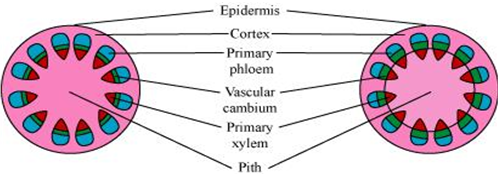
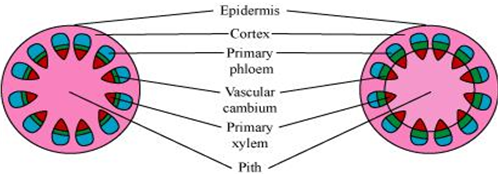
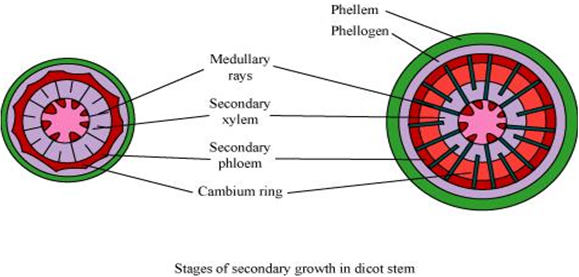
The secondary growth in plants:
i. Increases the girth of plants,
ii. Increases the amount of water and nutrients to support the growing number of leaves.
iii. Provides support to plants.
Draw illustrations to bring out anatomical difference between:
(a) Monocot root and dicot root
(b) Monocot stem and dicot stem
(a) Monocot root and dicot root: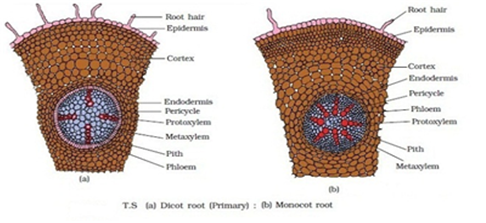
(b) Monocot stem and dicot stem: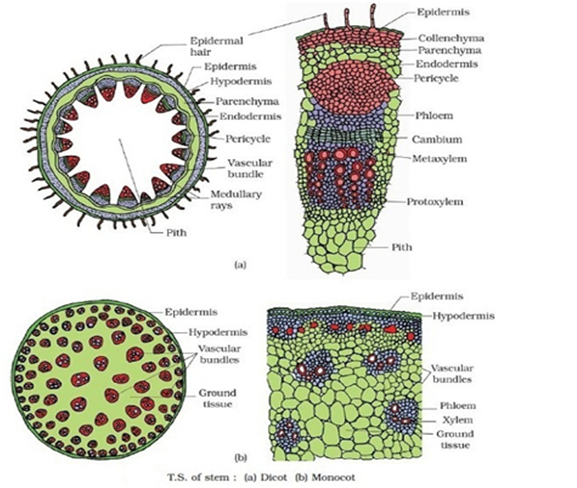
Cut a transverse section of young stem of a plant from your school garden and observe it under the microscope. How would you ascertain whether it is a monocot stem or a dicot stem? Give reasons.
We would ascertain whether the given stem is a monocot stem or dicot stem by looking at some characteristics which are unique as to the particular type.
The dicots stem is characterised by the following unique characters:
i. vascular bundles are arranged in a
ii. Each vascular bundle is conjoint, collateral, and open.
iii. Medullary rays are present between the vascular bundles.
iv. Pith is present.
If these characters are observed in the given stem, then it a dicot stem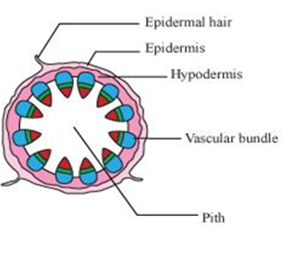
The monocot stem are characterised by the following unqiue characteristics:
1. Vascular bundles are scatttered.
2. Each vascular bundle is conjoint, collateral, and closed vascular bundles.
3. Medullary rays are absent. 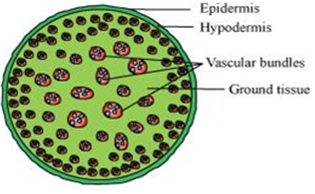
The transverse section of a plant material shows the following anatomical features:
(a) the vascular bundles are conjoint, scattered and surrounded by a sclerenchymatous bundle sheaths.
(b) phloem parenchyma is absent. What will you identify it as?
The scattered vascular bundles surrounded by sclerenchymatous bundle sheaths and the absence of the phloem parenchyma is unqiue to the monocot stem. Thus, the specimen is of a monocot stem.
Why are xylem and phloem called complex tissues?
Both the xylem and the phloem are made up of more than one type of the cells which work as a unit.
Xylem helps in conducting water and minerals. It is made up of the following components:
- Tracheids (xylem vessels and xylem tracheids)
- Xylem parenchyma
- Xylem fibres
Phloem helps in conducting food materials. It is composed of:
- Sieve tube elements
- Companion cells
- Phloem parenchyma
- Phloem fibres
What is stomatal apparatus? Explain the structure of stomata with a labelled diagram.
Stomata are small pores present in the epiderms of leaves.
The stomatal aperture, guard cells and the subsidiary cells together are called the stomatal apparatus.
Structure of stomata: Each stomata is composed of two bean-shaped structure called guard cells. In grasses the guard cell is dumbbell shaped. The inner walls of guard cells are thick, while the outer walls are thin. The guard cells are surrounded by subsidiary cells. These are the specialised epidermal cells present around the guard cells called the subsidiary cells.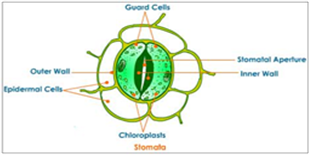
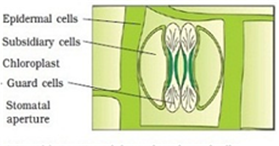
Name the three basic tissue systems in the flowering plants. Give the tissue names under each system.
The three basic tissue system in plants are:
(i) Epidermal tissue system: It forms the outermost covering of the whole plants body. It comprises of epidermal cells, stomata and the epidermal appendages like trichomes and hairs.
(ii) The vascular tissue system: It consists of the phloem and the xylem
(iii) Ground tissue system: All the tissues except the vascular bundles and the epidermis constitute the ground tissue system. For example parenchyma, collenchyma and sclerenchyma and mesophyll cells.
How is the study of plant anatomy useful to us?
The study of plant anatomy helps us to understand the structural adaptations of plants with respect to diverse environmental conditions. It also helps us to distinguish between monocots, dicots, and gymnosperms. Such a study is linked to plant physiology. Hence, it helps in the improvement of food crops. The study of plant-structure allows us to predict the strength of wood. This is useful in utilising it to its potential. The study of various plant fibres such as jute, flax, etc, helps in their commercial exploitation.
What is periderm? How does periderm formation take place in the dicot stems?
Periderm is composed of the phellogen, phellem, and phelloderm.
During secondary growth, the outer epidermal layer and the cortical layer are broken because of the cambium. To replace them, the cells of the cortex turn meristematic, giving rise to cork cambium or phellogen. It is composed of thin-walled, narrow and rectangular cells.
Phellogen cuts off cells on its either side. The cells cut off toward the outside give rise to the phellem or cork. The suberin deposits in its cell wall make it impervious to water. The inner walls give rise to the secondary cortex or phelloderm. The secondary cortex is parenchymatous.
Describe the internal structure of a dorsiventral leaf with the help of labelled diagrams.
Dorsiventral leaves are found in dicots. The vertical section of a dorsiventral leaf contains three distinct parts.
(i) Epiderms: Epiderms is present on both the upper surface (adaxial epiderms) and the lower surface (abaxial epiderms).
(ii) Mesophyll: Mesophyll is a tissue of the leaf present between the adaxial and abaxial epidermises. It is differentiated into the palisade parenchyma (composed of tall, compactly-placed cells) and the spongy parenchyma (comprising oval or round, loosely-arranged cells with inter cellular spaces). Mesophyll contains the chloroplasts which perform the function of photosynthesis.
(iii) Vascular system: The vascular bundles present in leaves are conjoint and closed. They are surrounded by thick layers of bundle-sheath cells.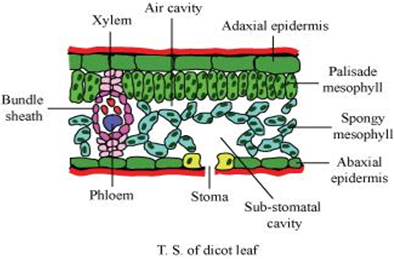
Cork cambium forms tissues that form the cork. Do you agree with this statement? Explain.
Cork cambium is a meristematic tissue which develops in the cortex region of a mature stem. Cork cambium is formed to replace the broken epidermal layer of the stem. The cells cut off on the outer side by cork cambium become cork. Hence, it can be said that the cork cambium is a tissue which forms the cork.
A transverse section of stem is stained first with safranin and then with fast green following the usual schedule of double staining for the preparation of a permanent slide. What would be the colour of the stained xylem and phloem?
Red and green
Green and Red
Orange and yellow
Purple and Orange
C.
Orange and yellow
Red and green
Identify the tissue system from among the following
Parenchyma
Xylem
Epidermis
Phloem
Parenchyma
Xylem
Epidermis
Phloem
C.
Epidermis
Match the followings and choose the correct option from below
A. Meristem i. Photosynthesis, storage
B. Parenchyma ii. mechanical support
C. Collenchyma iii. Actively dividing cells
D. Sclerenchyma iv. stomata
E. Epidermal tissue v. sclereids
Options:
a. A-i, B-iii, C-v, D-ii, E-iv
b. A-iii, B-i, C-ii, D-v, E-iv
c. A-ii, B-iv, C-v, D-i, E-iii
d. A-v, B-iv, C-iii, D-ii, E-i
B.
b. A-iii, B-i, C-ii, D-v, E-iv
Sponsor Area
Match the following and choose the correct option from below
A. Cuticle i. guard cells
B. Bulli form cells ii. single layer
C. Stomata iii. waxy layer
D. Epidermis iv. empty colourless cell
Options:
A-iii, B-iv, C-i, D-ii
A-i, B-ii, C-iii, D-iv
A-iii, B-ii, C-iv, D-i
A-iii, B-ii, C-i, D-iv
A.
A-iii, B-iv, C-i, D-ii
Interfascicular cambium and cork cambium are formed due to
Cell division
Cell differentiation
Cell dedifferentiation
Redifferentiation
C.
Cell dedifferentiation
Phellogen and Phellem respectively denote
Cork and cork cambium
Cork cambium and cork
Secondary cortex and cork
Cork and secondary cortex
B.
Cork cambium and cork
Fibres are likely to be absent in
Secondary phloem
Secondary xylem
Primary phloem
Leaves
B.
Secondary xylem
What is the fate of primary xylem in a dicot root showing extensive secondary growth?
It is retained in the centre of the axis
Its gets crushed
May or may not get crushed
It gets surrounded by primary phloem
A.
It is retained in the centre of the axis
Protoxylem is the first-formed xylem. If the protoxylem lies next to phloem what kind of arrangement of xylem would you call it?
Protoxylem refers to the xylem which is formed first.
If the protoxylem lies next to phloem then the arrangement is called Exarch.
What is the function of phloem parenchyma?
Phloem parenchyma performs the function of storage of food. It also helps in the translocation of food.
What is present on the surface of the leaves which helps the plant prevent loss of water but is absent in roots?
The cuticle is present on the surface of the leaves. It is a waxy layer which helps to prevent water loss.
Below is a list of plant fibres. From which part of the plant these are
obtained
a. Coir
b. Hemp
c. Cotton
d. Jute
a. Coir is obtained from Cotton husk.
b. Hemp - is obtained from the stem of Cannabis sativa
c. cotton is obtained from cotton seeds.
d. Jute is obtained from Corchorus capsularis.
Write the precise function of
a. Sieve tube
b. Interfasicular cambium
c. Collenchyma
d. Aerenchyma
The functions are :
a. Sieve tubes - Translocation of food.
b. Interfascicular cambium - Facilitate secondary growth
c. Collenchyma - Provides mechanical strength to young stem.
d. Aerenchyma - Provides buoyancy of floating plants
Palm is a monocotyledonous plant, yet it increases in girth. Why and how?
Palm shows an increase in girth because of the division and enlargement of the parenchymatous cells in the ground tissue. This type of growth is known as diffused secondary growth
Interfascicular cambium develops from the cells of
-
medullary rays
-
xylem parenchyma
-
endodermis
-
pericycle
A.
medullary rays
In dicot stems, the cells of cambium present between primary xylem and primary phloem are the intrafasicular cambium. The cells of medullary rays, adjoining these intrafascicular cambium become meristematic and form the interfascicular cambium. Xylem parenchyma is living and thin-walled and their cell walls are made up of cellulose. In dicot roots, the innermost layer of the cortex is called endodermis. Next to endodermis lies a few layers of thin-walled parenchymatous cells called as pericycle.
Lenticels are involved in
-
Transpiration
-
Gaseous exchange
-
Food transport
-
Photosynthesis
B.
Gaseous exchange
Plants have stomata and Lenticles involved in gaseous exchange. In stems, the living cells are organised in thin layers inside and beneath the bark. They have openings called Lenticles.
Companion cells are closely associated with
-
sieve elements
-
vessel elements
-
trichomes
-
guard cells
A.
sieve elements
Companion cells are characteristic elements of phloem tissue associated with the sieve tubes(sieve elements) in the angiosperms. The siever tubes and companion cells are related ontogenically as they develop from the same mother cell. The companion cells and sieve tubes maintain close cytoplasmic connections through plasmodesmata.
Sponsor Area
Closed vascular bundles lack
-
ground tissue
-
conjunctive tissue
-
cambium
-
pith
C.
cambium
In dicot system, cambium is present between phloem and xylem. Such vascular bundles, because of the presence of cambium, posses the ability to form secondary xylem and phloem tissues and hence, are called open vascular bundles. On the contrary, vascular bundles in monocots have no cambium. Hence, they do not form secondary tissues, and are referred to as closed.
Water containing cavities in vascular bundles are found in
-
sunflower
-
maize
-
Cycas
-
Pinus
B.
maize
In monocot stem like Zea mays, vascular bundles are conjoint, collateral and closed. In vascular bundles, the lowermost protoxylem vessels and xylem parenchyma cells dissolve forming a water containing schizolysigenous cavity called protoxylem cavity or lacuna or lysigenous cavity. Protoxylem cavity and protophloem may be absent in the smaller vascular bundles in maize.
To obtain virus - free healthy plants from a diseased one by tissue culture technique, which part/parts of the diseased plant will be taken?
-
Apical meristem only
-
Palisade parenchyma
-
Both apical and axillary meristems
-
Epidermis only
C.
Both apical and axillary meristems
Both apical and axillary meristems are free of virus for the healthy plant cultivation because of strong interferon activity in this region. These tissue form a protective impermeable covering around themselves, which s non-penetrable by any pathogen. Hence, these tissue are used in the production of disease-free plants by tissue culture.
As compared to a dicot root, a monocot root has
-
more abundant secondary xylem
-
many xylem bundles
-
inconspicuous annual rings
-
relatively thicker periderm
B.
many xylem bundles
The vasculature is radial in dicot root i.e.,xylem bundles alternate with phloem bundles. Usually vascular bundles are 2-6 in number while in monocot root the vascular strand consists of several (8 or more) alternate radial xylem and phloem bundles. Secondary growth takes place in dicot root while absent in monocot roots and annual rings do not form.
You are given a fairly old piece of dicot stem and a dicot root. Which of the following anatomical structure will you use to distinguish between the two?
-
Secondary xylem
-
Secondary phloem
-
Protoxylem
-
Cortical cells
C.
Protoxylem
In dicot stem, the protoxylem is present towards the center (pith) and metaxylem is present towards the periphery of the organ. This type of xylem is known as endarch. In root, the protoxylem is present towards periphery and metaxylem present towards the centre that is called exarch.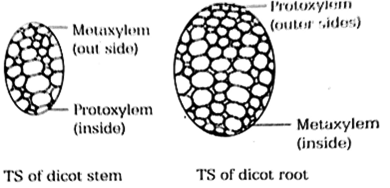
Vascular bundles in monocotyledons are considered closed because
-
a bundle sheath surrounds each bundle
-
cambium is absent
-
there are no vessels with perforations
-
xylem is surrounded all around by phloem
B.
cambium is absent
The vascular bundles of monocots do not contain a layer of meristematic tissue (cambium). There is absence of meristematic tissue near vascular bundles, therefore vascular system is closed in monocot. Hence, the further secondary growth is not seen in them.
So, option (b) goes with question.
A major characteristic of the monocot root is the presence of
-
Open vascular bundles
-
Scattered vascular bundles
-
Vasculature without cambium
-
Cambium sandwiched between phloem and xylem along the radius
C.
Vasculature without cambium
The characteristic feature of monocot root is presence of vasculature without cambium. The vascular bundles are alternate and radial and arranged in the form of a ring around a central pith. Phloem and xylem bundles are separated by narrow strips called conjunctive tissue and it does not take part in cambium formation. So, the vascular bundles in monocots are closed and do not show any secondary growth.
The 'Eyes' of the potato tuber are
-
flower buds
-
shoot buds
-
axillary buds
-
root buds
C.
axillary buds
Tuber is oval or spherical swollen underground modified stem lacking adventitious roots. It possesses a number of spirally arranged depressions called eyes. Each eye represents node and consists of 1-3 axillary buds in the axils of small scally leaves.
In land plants, the guard cells differ from other epidermal cells in having
-
mitochondria
-
endoplasmic reticulum
-
chloroplasts
-
cytoskeleton
C.
chloroplasts
The guard cells of stomata in land plants are specialised epidermal cells which contain chloroplasts. In rest of epidermal cells, chloroplasts are absent. But chloroplasts of guard cells are capable of poor photosynthesis as there is the absence of NADP reductase enzyme.
The cork cambium, cork and secondary cortex are collectively called
-
Phellogen
-
Periderm
-
phellem
-
phelloderm
B.
Periderm
The periderm is a secondary protective structure and is made up of cork cambium (phellogen), cork (phellem) and secondary cortex (phelloderm)
Function of copanion cells is
-
providing energy to sleve elements for active transport
-
Providing water to phloem
-
loading of sucrose into sieve elements by passive transport
-
Loading of sucrose into sieve elements
D.
Loading of sucrose into sieve elements
The companion cells are specialised parenchyma cells, which are closely associated with sieve tube elements. The sieve tube elements and companion cells help in maintaining the pressure gradient in the sieve tubes. they also function in the loading of sucrose into sieve elements actively.
Some vascular bundles are described as open because these
-
are surrounded by pericycle but no endodermis
-
are capable of producing secondary xylem and phloem
-
Possess conjunctive tissue between xylem and phloem
-
are not surrounded by pericycle
B.
are capable of producing secondary xylem and phloem
In open vascular bundle, cambium is present between xylem and phloem of the same vascular bundle, eg, dicot stems.Due to the presence of cambium, secondary growth in stem occurs and secondary permanent tissues (secondary xylem, secondary phloem and vascular rays) are formed.
Which one of the following is not a lateral meristem?
-
Intrafascicular cambium
-
interfascicular cambium
-
Phellogen
-
Intercalary meristem
D.
Intercalary meristem
Intercalary meristems are the portions of apical meristems, which are separated from the apex during the growth of axis and formation of permanent tissue. It is present mostly at the base of the node (eg, Mentha virridis), the base of internode (eg, the stem of many monocots viz, wheat, paddy, grasses; pteridophytes like Equisetum) or at teh base of the leaf (eg Pinus).
Heartwood differs from sapwood in
-
Presence of rays and fibres
-
the absence of vessels and parenchyma
-
having dead and non-conducting elements
-
being susceptible to pests and pathogens
C.
having dead and non-conducting elements
As a result of continued secondary growth in subsequent years, the older part of secondary xylem or wood becomes non - functional as it loses the power of conduction. The cells of this wood are filled with resins or tennis produced by adjacent functional, secondary xylem becomes hard, durable and blackish in colour, called heartwood, Now, the function of secondary xylem( water and mineral conduction from roots) is performed by outer younger-rings of xylem, which is called sapwood.
Transport of food material in higher plants takes place through
-
companion cells
-
transfusion tissue
-
tracheids
-
sieve elements
D.
sieve elements
Sieve elements are the food conducting cells of phloem tissue. Sieve element in angiosperms are sieve tubes, while in gymnosperms and pteridophytes, these are sieve cells.
Black (stem) rust of wheat is caused by
-
Alternaria solani
-
Ustilago nuda
-
Puccinia graminis
-
Xanthomonas oryzae
C.
Puccinia graminis
Black (stem) rust of Wheat is caused by Puccinia graminis tritici, a fungus belonging to Sub-class-Teliomycetidae, Order-Uredinales. It is a heteroecious species which completes its life cycle on two plants, ie, barberry (Berberis) plant and wheat (Triticum aestivum).
Aestivation of petals in the flower of cotton is correctly shown in
C.

Petals in the flowers of cotton (Gossypium sp) china rose (Hibiscus rosa sinesis), etc, show twisted aestivation. In this type of aestivation, a regular overlapping of petals occurs where one margin of each petal overlaps with the next one petal.
The annular and spirally thickened conducting elements generally develop in the protoxylem when the root or stem is
-
maturing
-
elongating
-
widening
-
differentiating
C.
widening
Vessel or tracheae are made up of a row of cells, placed one above the other, with their intervening walls absent or variously pored. The walls of vessels are lignified and hard, but not very thick. The cell cavity or the lumen is wide. The thickening may be annuler, spiral, scalariform, reticulate and pitted.
In barley stem, vascular bundles are
-
open and scattered
-
closed and scattered
-
open and in a ring
-
closed and radial
B.
closed and scattered
The vascular bundles in Hordeum vulgare (barley) plant are scattered in ground tissue, many in number and vary in size-smaller towards the periphery and bigger towards the centre of the ground tissue, oval or rounded in outline, conjoint, collateral and closed.
Vascular tissue in flowering plants develop from
-
phellogen
-
plerome
-
periblem
-
dermatogen
B.
plerome
Histogen theory for shoot apical meristem has been proposed by Hastein (1870).It advocates that there are three distinct meristematic zones (layers) called dermatogen periblem and plerome. The dermatogen is the outermost histogen giving rise to the epidermis, periblem is the middle one producing the cortex and plerome is the innermost resulting in the certain cylinder (ie, vascular tissue).
Cork cambium (phellogen) is the secondary lateral meristem found in the outer cortical region. Its cells divide periclinally cutting offf cells towards the outside (formingcork or phellem) and inside (forming secondary cortex or phelloderm).
For a critical study of secondary growth in plants. which one of the following pairs is suitable?
-
Sugarcane and sunflower
-
Teak and pine
-
Deodar and fern
-
Wheat and maiden hair fern
B.
Teak and pine
The increase in diameter or thickness is due to the formation of secondary tissues as a result of the activities of vascular cambium and cork cambium. This secondary growth is characteristic of dicot stem and root.
A common structural feature of vessel elements and sieve tube elements is
-
thick secondary walls
-
pores on lateral walls
-
presence of P-protein
-
enucleate condition
B.
pores on lateral walls
The wall of both vessel and sieve tube elements are perforated by large opening. Due to this adaptation, the cell to cell contact is possible. The vessels are nucleated whereas the sieve tube elements are enucleated.
Root hairs develop from the region of
-
Maturation
-
Elongation
-
Root cap
-
Meristematic activity
A.
Maturation
The vascular cambium normally gives rise to
-
Phelloderm
-
Primary phloem
-
Secondary xylem
-
Periderm
C.
Secondary xylem
Identify the wrong statement in context of heartwood.
-
Organic compounds are deposited in it
-
It is highly durable
-
It conducts water and minerals efficiently
-
It comprises dead elements with highly lignified walls
C.
It conducts water and minerals efficiently
Heartwood is physiologically inactive due to deposition of organic compounds and tyloses formation, so this will not conduct water and minerals
Casparian strips occur in
Epidermis
Pericycle
Endodermis
Cortex
C.
Endodermis
- Endodermis has Casparian strip on radial and inner tangential wall.
- It is suberin rich.
Secondary xylem and phloem in dicot stem are produced by
Apical meristems
Vascular cambium
Axillary meristems
Phellogen
B.
Vascular cambium
Vascular cambium is partially secondary.
Form secondary xylem towards its inside and secondary phloem towards outsides.
4 – 10 times more secondary xylem is produced than secondary phloem.
First vascular plant is
Thallophyta
Pteridophyta
Bryophyta
Spermatophyta
B.
Pteridophyta
Pteridophyte is called vascular cryptogams. They are a seedless vascular plant as they posses water-conducting xylem and food translocating phloem but do not produce seed (instead spare formation takes place).
Angular collenchyma occurs in
Salvia
Helianthus
Althaea
Cucurbita
D.
Cucurbita
Angular collenchyma occurs in Cucurbita. It has thickening at the angles and there are no intercellular spaces. It is generally found in leaf petioles.
Kranz anatomy can be obseved in leaves of
Sorghum
Spinach
Mustrad
Tulip
A.
Sorghum
Kranz anatomy is found in C-plants, e.g., Sorghum, Zea mays, Saccharum officinarum. It is characterised by connective, undifferentiated mesophyll around vascular bundles with chloroplast containing bundle sheath.
The term 'bark' refers to
Phellem, phelloderm and vascular cambium
Periderm and secondary xylem
Cork cambium and cork
Phellogen, phellem, phelloderm and Secondary phloem
D.
Phellogen, phellem, phelloderm and Secondary phloem
All the dead cells lying outside the phellogen constitute the bark of the plant. It may include epidermis, cork, hypodermis and even part of cortex depending upon the position of the origin of cork cambium or phellogen.
What differentiates leaf of dicots from monocots?
Parallel venation
Differentiation of palisade and spongy parenchyma
Stomata only on upper side
Stomata both on upper and lower sides
B.
Differentiation of palisade and spongy parenchyma
Main differences between dicot and monocot leaves are as follows:
| Character | Dicot leaf | Monocot leaf |
| Type of leaf | Dorsiventral | Isobilateral |
| Stomata | Have more stomata on lower epidermis. | Have an equal number of stomata on upper and lower epidermis. |
| Mesophyll | Differentiated into 2 parts: upper palisade and lower spongy. | Undifferentiated |
| Bundle sheath | It is single layered and made up of parenchymatous cells. | It may be single or double layered and made up of sclerenchymatous cells. |
| Bulliform cells | Absent | Present; it helps in rolling and unrolling of leaves. |
| Venation | Reticulate | Parallel |
Duramen is present in
inner region of secondary wood
part of sap wood
outer region of secondary wood
region of pericycle
A.
inner region of secondary wood
The xylem elements of the stems of a number of trees develop dark brown colour, especially in the central or innermost layers.
It comprises dead element with higly lignified walls and is called heart wood or duramen. It is present in inner region of secondary wood.
Meristematic tissue in vascular bundle is
phellem
procambium
interfascicular cambium
fascicular cambium
D.
fascicular cambium
The cambium present between the xylem and phloem of vascular bundle is called vascular cambium. It is a lateral meristem that gives rise to secondary xylem and phloem and occurs in the form of a thin strip. Vascular cambium is also called fascicular cambium.
Quiescent centre is the zone of
least mitotic activity in the root apex
least mitotic activity in the shoot apex
maximum mitotic activity in the root apex
maximum mitotic activity in the shoot apex
A.
least mitotic activity in the root apex
Quiescent centre is an area at the top of the root apical meristem where the cells have least mitotic activity i.e., the rate of cell division is lower than in surrounding tissue. But the cell retains the meristematic property ones the meristamatic cells sourrounding them are damaged.
Ectophloic siphonostele is found in
Adiantum and Cucurbitaceae
Osmunda and Equisetum
Marsilea and Botrychium
Dicksonia and maiden hair fem
B.
Osmunda and Equisetum
In the ectophloic siphonostele the xylem surrounds pith and this xylem is surrounded by phloem, pericycle and endoderm is respectively.
eg, Osmunda and Equisetum.
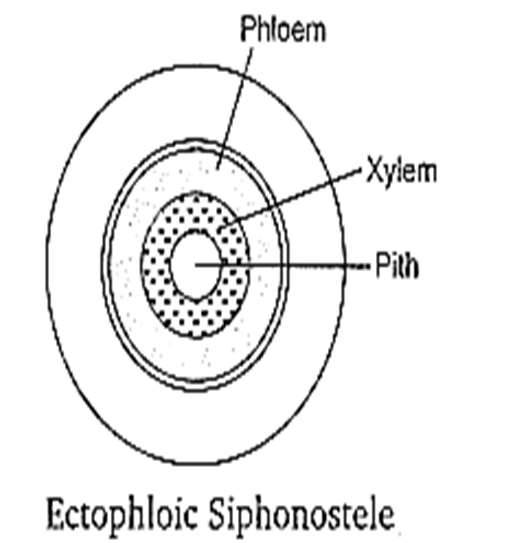
In a woody dicotyledonous tree, which of the following parts will mainly consist of primary tissues?
Stem and root
All parts
Shoot tips and root tips
Flowers, fruits and leaves
C.
Shoot tips and root tips
Primary tissues are those meristematic tissues, which are derived directly from embryonal tissues, e.g., shoot apex and root apex.
In monocot roots which types of vascular bundles are found?
Collateral, conjoint and closed
Radial with exarch xylem
Bicollateral, conjoint and closed
Radial with endarch xylem
B.
Radial with exarch xylem
When xylem and phloem groups are located on different radii, the bundles are said to be radial e.g. root. The protoxylem element lie at the periphery and metaxylem in the centre, this condition is called exarch e.g. root.
Periderm includes
cork cambium only
cork cambium and cork
cork and secondary cortex
cork cambium, cork and secondary cortex
D.
cork cambium, cork and secondary cortex
Periderm formation occurs in the root and stems of dicots and gymnosperm in extra stelar region with the help of cork cambium. Periderm is external secondary protective tissue and compreses of cork, cork cambium and secondary cortex.
Sponsor Area
As secondary growth proceeds, in a dicot stem, the thickness of
sapwood increases
heartwood increases
both sapwood and heartwood increases
both sapwood and heartwood remains the same
B.
heartwood increases
In a woody stem, due to secondary growth, secondary xylem constitutes the bulk of the stem and is commonly called wood. Width of secondary xylem increases continuously with the age of the plant.
Older stem have two regions- younger sapwood and older heartwood. Both sapwood and heartwood increase in size initially, but when a tree reaches a certain age, amount of heartwood increases and the amount of sapwood remains constant.
Bark refers to
phellem + phellogen + phelloderm
periderm + cortex
phellem + phelloderm + secondary phloem
periderm + cortex + pericycle + secondary phloem
D.
periderm + cortex + pericycle + secondary phloem
Bark is a loose term and is used to define all the tissues outside vascular cambium. It is the outermost layer of stems and roots of woody plants. It is further differentiated into outer bark or rhytidome (consisting of dead cells) and inner bark (of living cells, i.e., periderm, cortex, pericycle and secondary phloem). The outer layer of the bark are being constantly peeled off on account of the formation of new secondary vascular tissues in the interior. Bark is insect repellent, decay proof, fire-proof and acts as a heat screen.
Jute fibres deteriorate quickly because
cellulose content is high
lignin content is high
cellulose content is low
lignin content is low
B.
lignin content is high
Lignin is a complex organic polymer that is deposited within the cellulose of plant cells. The lignin content is high in jute fibres which causes deterioration very quickly.
Assertion : In woody stems, the amount of heart wood continues to increase year after year.
Reason : The cambial activity continues uninterrupted.
If both assertion and reason are true and reason is the correct explanation of assertion
If both assertion and reason are true but reason is not the correct explanation of assertion
If assertion is true but reason is false
If both assertion and reason are false
A.
If both assertion and reason are true and reason is the correct explanation of assertion
Heartwood formation occurs spontaneously because it is a genetically programmed process. As a result of continued secondary growth for several years, the older parts of the stem and its old branches have a part of its secondary xylem rendered non - functional. Therfore, heart wood is a modified or non- functional secondary xylem. It is also known as duramen. Sap wood is the functional outer younger rings of secondary xylem. It is also known as alburnum. With the passage of time and addition of new outer rings of secondary xylem due to cambial activity more rings ofthe sap wood are changed into heart wood. This leads to the increase in the thickness of heart wood, whereas the sap wood remains of about the same thickness.
Assertion : Petroplants produce large amount of latex.
Reason : The latex contains long chain hydrocarbons.
If both assertion and reason are true and reason is the correct explanation of assertion
If both assertion and reason are true but reason is not the correct explanation of assertion
If assertion is true but reason is false
If both assertion and reason are false
A.
If both assertion and reason are true and reason is the correct explanation of assertion
Latex of some plants containing long chain hydrocarbons is considered to be a good substitute for liquid fuels or petroleum. Therefore, plants having large amount of latex with long chain hydrocarbons are known as petroplants. Cultivation of petroplants is also a part of energy-cropping.
The most common petroplants belong to families of Euphorbiaceae, Asclepiadaceae, Apocynaceae, Compositae, Labiatae, Sapotaceae, Urticaceae, etc., which have property of converting large amounts of their photosynthates into latex with hydrocarbons. Their hydrocarbon contents can be increased by genetic manipulations (genetic engineering). But commercial production of petroleum or liquid fuel alternative (through petroplants) is in early stage. The use of these petroplants may reduce the pressure on liquid fuel or petroleum.
Which one of the following statements pertaining to plant structure is correct?
Cork lacks stomata, but lenticels carry out transpiration.
Passage cells help in transfer of food from cortex to phloem
Sieve tube elements possess cytoplasm but no nuclei.
The shoot apical meristem has a quiescent centre
C.
Sieve tube elements possess cytoplasm but no nuclei.
Sieve tubes in flowering plants consists of elongated living cells of the phloem. Their main function is to transport sugars and other important molecules necessary for plants. On maturity, these loose nucleus and other cellular organelles.
Mature cork cells are plant cells that form the protective water resistant tissue in the outer covering of stems and trunks. They are genetically programmed not to divide, but instead to remain as they are dead cells. They also possess lenticels. A lenticel is produced beneath a former stomata or stoma of the epidermis. They encloses intercellular space for gaseous exchange.
Passage cells help in transfer of water from cortex. Quiescent centre is present in root apical meristem.
Plasmodesmata connections help in
cytoplasmic streaming
synchronous mitotic divisions
locomotion of unicellular organism
movement of substances between cells
D.
movement of substances between cells
A characteristic of most plant cells is the presence of cytoplasmic material that establish continuity between adjacent cells. These bridges are called plasmodesmata. These permit the free circulation of fluid, which is essential to the maintenance of plant cell toxicity.
The quiescent centre in root meristem serves as a
site for storage of food which is utilized during maturation
reservoir of growth hormones
reserve for replenishment of damaged cells of the meristem
region for absorption of water
C.
reserve for replenishment of damaged cells of the meristem
Quiescent centre is a region in the apical meristem of a root where cell division proceeds very slowly. It is a hemispherical region of inactive cells present in between the root cap and the active meristematic region of root apex. This zone contains several hundred cells which are characterized by having lower concentration of DNA, RNA and protein. The quiescent centre acts as reservoir of cells and becomes active whenever the previously active initials get damaged or during the establishment of the secondary roots.
Assertion : Water and mineral uptake by root hairs from the soil occurs through apoplast until it reaches endodermis.
Reason : Casparian strips in endodermis are suberized
If both Assertion and Reason are true and the reason is the correct explanation of the assertion
If both Assertion and Reason are true but the reason is not the correct explanation of the assertion
If Assertion is true statement but Reason is false
If both Assertion and Reason are false statements
B.
If both Assertion and Reason are true but the reason is not the correct explanation of the assertion
The apoplast is the system of adjacent cell walls which is continuous through the plant. As water evaporates from the mesophyll cell walls into the intercellular air spaces, tension develops in the continuous stream of water in the apoplast, and water is drawn through the walls in a mass flow by the cohesion of water molecules. When water moving through spaces in the cell wall reaches the endodermis, it's progress is stopped by a waterproof substance called suberin which is deposited in cell walls in the form of bands called casparian strips. Therefore water and solutes must pass through the cell surface membrane and into the cytoplasm of the cells of the endodermis.
In a dicotyledonous stem, the sequence of tissues from the outside to the inside is
phellem - pericycle - endodermis - phloem
phellem - phloem - endodermis - pericycle
phellem - endodermis - pericycle - phloem
pericycle - phellem - endodermis - phloem
C.
phellem - endodermis - pericycle - phloem
Phellem or cork is a tissue formed on the outer side of phellogen or cork cambium. It is protective in function.
Endodermis is the boundary between the cortex and the stele. It is a distinctly visible layer of cells immediately outside the vascular cylinder in roots and shoots.
Pericycle regulates the formation of lateral roots by rapidly dividing near the xylem elements of the root.
Phloem is the vascular tissue in plants which conducts sugars and other metabolic products downwards from the leaves.

Casparian strips are present in :
cortex
epidermis
endodermis
C.
endodermis
The casparian strips are thick depositions of lignin or suberin on the walls of eridodermis. These are impervious to water and has discovered by Caspari.
When does a plant wilt?
When phloem is blocked
When xylem is blocked
Pith is removed
A few leaves are removed
B.
When xylem is blocked
Wilting is the loss of turgidity of leaves and other soft aerial parts of a plant causing their drooping, folding and rolling. It is caused by blocking of xylem.
In the following pairs, where do you get lignin in both the element?
Tracheid and collenchyma
Sclerenchyma and sieve tube
Sclerenchyma and trachea
Parenchyma and endodermis
C.
Sclerenchyma and trachea
The cells of sclerenchyma are long or short, narrow, thick walled and lignified. These are dead cells and do not perform any metabolic function. Tracheids (tracheary element) are elongated cells with tapering ends. The wall of tracheids is moderatly thick and usually lignified.
One of the characteristic of sieve tube is
it is a part of phloem
function is transport of inorganic solutes
it is dead cell
sieve plate is not present
A.
it is a part of phloem
The phloem consists of sieve elements companion cells, phloem fibres and phloem parenchyma. Sieve tube members are long, slender, tube-like cells joined end to end to form long tubular channels, the sieve tubes.
Pith is absent in
protostele
eustele
amphiphloic stele
ectophloic stele
A.
protostele
Protostele is simplest and most primitive type of stele, in which, vascular cylinder consists of solid core of xylem surrounded by phloem, pericycle and endodermis. There is no pith.
Quiescent centre is found in plants at
root tip
cambium
shoot tip
leaf tip
A.
root tip
Quiescent centre is a region in the apical meristem of a root where cell division proceeds very slowly or not at all. Although, the cells are capable of resuming meristematic activity should tissue surrounding them to be damaged.
Interfascicular cambium is a
primary meristematic tissue
primordial meristem
type of protoderm
secondary meristematic tissue
D.
secondary meristematic tissue
The meristem that occurs in the mature regions of roots and shoots of many plants, particularly those that produce woody axis and appea later than primary meristem is called the secondary or lateral meristem. They are cylindrical meristems. Fascicular vascular cambium, interfascicular cambium and cork cambium are examples of lateral meristems. These are mainly responsible for producing secondary tissues.
Portion of apical meristem that gives xylem tissue is called
protoxylem
procambium
metaxylem
tracheid
B.
procambium
Procambiumis a tissue of narrow, elongated, prosenchymatous meristematic cells in vascular plants. It is grouped into strands differentiating just behind growing points of stems and roots and gives rise to vascular tissue.
Interfascicular cambium develops from the cells of
medullary rays
xylem parenchyma
endodermis
pericycle
A.
medullary rays
In dicot stems, the cells of cambium present between primary xylem and primary phloem is the intrafasicular cambium. The cells of medullary rays, adjoining these intrafascicular cambium become meristematic and form the interfascicular cambium.
In dicot roots the innermost layer of the cortex is called endodermis. Next to endodermis lies a few layers of thick-walled parenchymatous cells called as pericycle.
Lenticels are involved in
transpiration
gaseous exchange
food transport
photosynthesis
B.
gaseous exchange
Plants have stomata and lenticles involved in gaseous exchange. In stems the living cells are organised in thin layers inside and beneath the bark. They have openings called lenticles.
Transpiration is the evaporative loss of water by plants. It occurs mainly through stomata in leaves.
Food transport occurs by the vascular tissue phloem from a source to a sink.
Photosynthesis is a physico-chemical process by which they use light energy to derive re- synthesis of organic compounds.
Age of a tree can be estimated by
its height and girth
biomass
number of annual rings
diameter of its heartwood
C.
number of annual rings
Age of a tree can be estimated by number of annual rings. The two kinds of woods that appear as alternate concentric rings, constitute an annual ring heartwood comprises dead elements with highly lignified walls that give mechanical support to the stem. The height and girth of a tree increases due to the activity of vascular cambium.
Medullary rays are tissues made up of
phloem parenchyma
xylem parenchyma
sieve tube
sclerenchyma
B.
xylem parenchyma
Medullary rays are the vertical plates of parenchyma cells running radially through the cylinder of vascular tissue in the stems and roots of plants. Each may be one to many cell in width.
Primary medullary rays occur in young plants and in those not showing secondary thickening. They pass from the cortex to the pith.
Secondary medullary rays are produced by the vascular cambium and terminate in xylem and phloem tissues. Medullary rays store and transport food materials.
A dicotyledonous plant forms crown gall when
Agrobacterium tumefaciens comes in contact with the plant
Agrobacterium rhizogenes comes in contact with the plant
a specific part of DNA from the Ti-plasmid gets integrated with the plant chromosome
a specific part of DNA from the Ri-plasmid gets integrated with the plant chromosome
C.
a specific part of DNA from the Ti-plasmid gets integrated with the plant chromosome
Agrobacterium tumifaciens causes Crown gall disease in dicotlyledonous plants. It infects the plant through its Ti- plasmid that integrates a segment of its DNA. Hence, it is known as T- DNA.
Match the following Columns
| Column I | Column II |
| A. Tracheids | 1. Cells posses highly thickness walls with obliterates central lumen |
| B. Vessels | 2. Elongated tube like cells with thick lignified walls and tampering ends |
| C. Xylem parenchyma | 3. Individual members are interconnected through perforations in their common walls |
| D. Xylem fibres | 4. Cells are living with thin cellulosic cell walls. |
The correct answer is
A- 2; B- 3; C- 4; D- 1
A- 2; B- 4; C- 1; D- 3
A- 3; B- 2; C- 4; D- 1
A- 2; B- 3; C- 1; D- 4
C.
A- 3; B- 2; C- 4; D- 1
| Column I | Column II |
| A. Tracheids | 3. Individual members are interconnected through perforations in their common walls |
| B. Vessels | 2. Elonagated tube like cells with thick lignified walls and tampering ends |
| C. Xylem parenchyma | 4. Cells are living with thin cellulosic cell walls |
| D. Xylem fibres | 1. Cells posses highly thickness walls with obliterated central lumen |
If there is more than one tunica layer in stem apex, which among the following is most likely to happen?
All the layers will develop into epidermal cells
Only the outer layer will develop into epidermal cells
All the layers will develop into cortex
Inner layer develops into cortex
B.
Only the outer layer will develop into epidermal cells
Even, if there is more than one tunica layer in stem apex, only the outer layer will develop into epidermal cells. The stem has three simple cell types, i.e. the parenchyma, collenchyma and sclerenchyma cells that are responsible for metabolic functions, repairing and healing wounds and storing starch.
Which of the following region of root is responsible for increase in length of root?
Root cap region
Meristematic region
Region of elongation
Mature region
C.
Region of elongation
Region of elongation is present just above to the meristematic region, it is about 2-5 mm in length. In this region the cells elongate resulting in increase in length. Root cap protects the root from injury at the time of growth.
The dark coloured dead wood present in the central region of old tree is
spring wood
heart wood
sap wood
cambium
B.
heart wood
Heart wood is also known as dead wood which is formed by the lignification or resin collection in sap wood. The wood is called secondary xylem. The cambium is in the ring of meristematic cell which produce secondary
xylem and phloem in dicots.
Enucleated cells at maturity are
palisade cells
guard cells
companion cells
sieve elements
D.
sieve elements
An enucleated cell is a cell where the nucleus, and thus all genetic information, has been removed. Sieve elements are living enucleated structures.
Atactostele vascular bundles are
scattered in the ground tissue
three in number
in form of ting around
broken vascular bundles
A.
scattered in the ground tissue
Actactostele is a type of eustele, found in monocots, in which the vascular tissue in the stem exists as scattered bundles.
Which of the following clogs the cavity of the xylem vessels?
Tylosis
Cystolith
Hydathode
Raphide
A.
Tylosis
Tyloses develop in tracheary elements as the balloon like enlargements due to protrusions axial and ray parenchyma cells. This clogs the cavity of the xylem vessels.
Phloem parenchyma is absent in
monocot stem
dicot stem
dicot root'
dicot leaf
A.
monocot stem
The parenchyma when associated with the phloem is called phloem parenchyma. They are present in pteridophytes and most of dicotyledonous angiosperms. Phloem Parenchyma are absent in monocots and few dicots like Ranunculus.
Grafting is not possible in monocots because they
lack cambium
have scattered vascular bundles
have parallel venation
are herbaceous
A.
lack cambium
The monocots lack cambium and therefore, secondary growth also. Hence, the grafting is not possible in monocots.
Which is present in monocot flowers?
Sepals
Petals
Tepals
None of these
C.
Tepals
Tepals are individual parianth segments. The parianth is collective name as undifferentiated sepals and petals. These are found in monocot flowers. The parianth segment of Gramineae are called lodicules.
Quiescent centre is found in root apex and acts as
permanent source of active initiates
reservoir of resistant cells
reservoir of passive cells to form new root apex if root apex is damaged/ killed
all of the above
D.
all of the above
In the root apex of angiosperm, cup shaped zone of inactive cells is known as quiescent centre. These cells do not divide. Instead, they become active, whenever the active initials are damaged. It also acts as a reservoir of cells relatively resistant to change.
Which type of meristems allow the fallen stems of cereals/ grasses to become erect?
Apical meristem
Lateral meristem
Intercalary meristem
Secondary meristem
C.
Intercalary meristem
Intercalary meristem lies between region of permanent tissue. It is a part of primary meristem attached by a permanent tissue. It is present in the intemodal regions of grasses and also sometimes in nodal region.
An open collateral bundle is one in which :
xylem and phloem are seprated by cambium;
xylem and phloem lie side by side
cambium occurs on the out side of bundle
cambium does not occur in the bundle
A.
xylem and phloem are seprated by cambium;
Collateral bundle, that is, phloem on outside and xylem on inner side. It is open when a strip of cambium is present between xylem and phloem. e.g., dicot and Gymnosperms stem.
Cook cambium and vascular cambium are :
parts of secondary xylem and phloem
parts of pericycle
lateral meristems
apical meristems
C.
lateral meristems
Cork cambium and vascular cambium are lateral meristems and responsible for growth in thickness.
Mock Test Series
Sponsor Area
Sponsor Area






